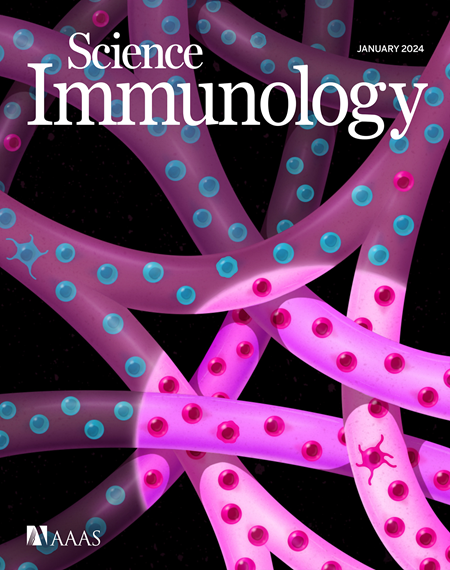MAIT and other innate-like T cells integrate adaptive immune responses to modulate interval-dependent reactogenicity to mRNA vaccines
IF 16.3
1区 医学
Q1 IMMUNOLOGY
引用次数: 0
Abstract
Adenoviral (Ad) vectors and mRNA vaccines exhibit distinct patterns of immune responses and reactogenicity, but underpinning mechanisms remain unclear. We longitudinally compared homologous ChAdOx1 nCoV-19 and BNT162b2 vaccination, focusing on cytokine-responsive innate-like lymphocytes—mucosal-associated invariant T (MAIT) cells and Vδ2+ γδ T cells—which sense and tune innate-adaptive cross-talk. Ad priming elicited robust type I interferon (IFN)–mediated innate-like T cell activation, augmenting T cell responses (innate-to-adaptive signaling), which was dampened at boost by antivector immunity. Conversely, mRNA boosting enhanced innate-like responses, driven by prime-induced spike-specific memory T cell–derived IFN-γ (adaptive-to-innate signaling). Extending the dosing interval dampened inflammation at boost because of waning T cell memory. In a separate vaccine trial, preboost spike-specific T cells predicted severe mRNA reactogenicity regardless of the priming platform or interval. Overall, bidirectional innate-like and adaptive cross-talk, and IFN-γ–licensed innate-like T cells, orchestrate interval-dependent early vaccine responses, suggesting modifiable targets for safer, more effective regimens.

MAIT和其他先天样T细胞整合适应性免疫反应来调节mRNA疫苗的间隔依赖性反应原性
腺病毒(Ad)载体和mRNA疫苗表现出不同的免疫反应模式和反应原性,但其基本机制尚不清楚。我们纵向比较了同源的ChAdOx1 nCoV-19和BNT162b2疫苗接种,重点关注细胞因子反应性先天样淋巴细胞-粘膜相关不变T (MAIT)细胞和Vδ2+ γδ T细胞-感知和调节先天适应性串音。Ad启动引发了I型干扰素(IFN)介导的强大的先天样T细胞激活,增强了T细胞反应(先天到适应性的信号传导),这种反应在抗载体免疫的增强下被抑制。相反,mRNA促进先天样反应,由启动物诱导的spike-specific memory T细胞衍生的IFN-γ (adaptive-to-innate signaling)驱动。延长给药间隔可以抑制炎症,因为T细胞记忆减弱。在一项单独的疫苗试验中,无论启动平台或间隔如何,预增强刺突特异性T细胞预测严重的mRNA反应性。总的来说,双向先天样和适应性串扰,以及IFN-γ许可的先天样T细胞,协调间隔依赖性的早期疫苗反应,提出了更安全,更有效的方案的可修改靶点。
本文章由计算机程序翻译,如有差异,请以英文原文为准。
求助全文
约1分钟内获得全文
求助全文
来源期刊

Science Immunology
Immunology and Microbiology-Immunology
CiteScore
32.90
自引率
2.00%
发文量
183
期刊介绍:
Science Immunology is a peer-reviewed journal that publishes original research articles in the field of immunology. The journal encourages the submission of research findings from all areas of immunology, including studies on innate and adaptive immunity, immune cell development and differentiation, immunogenomics, systems immunology, structural immunology, antigen presentation, immunometabolism, and mucosal immunology. Additionally, the journal covers research on immune contributions to health and disease, such as host defense, inflammation, cancer immunology, autoimmunity, allergy, transplantation, and immunodeficiency. Science Immunology maintains the same high-quality standard as other journals in the Science family and aims to facilitate understanding of the immune system by showcasing innovative advances in immunology research from all organisms and model systems, including humans.
 求助内容:
求助内容: 应助结果提醒方式:
应助结果提醒方式:


